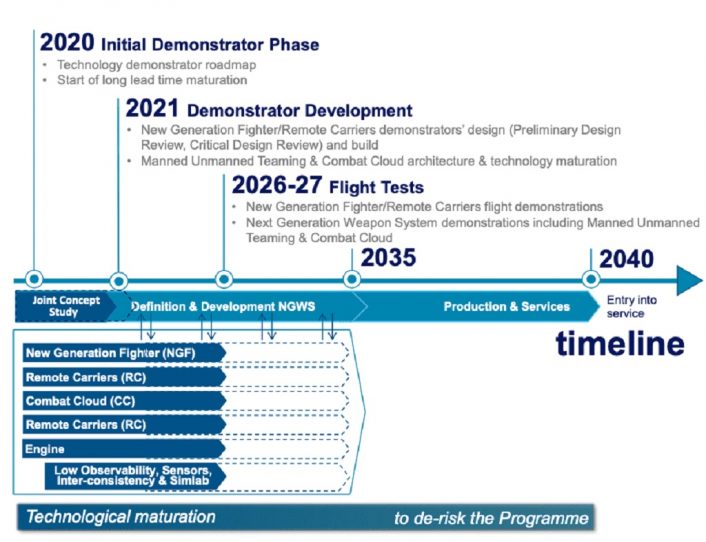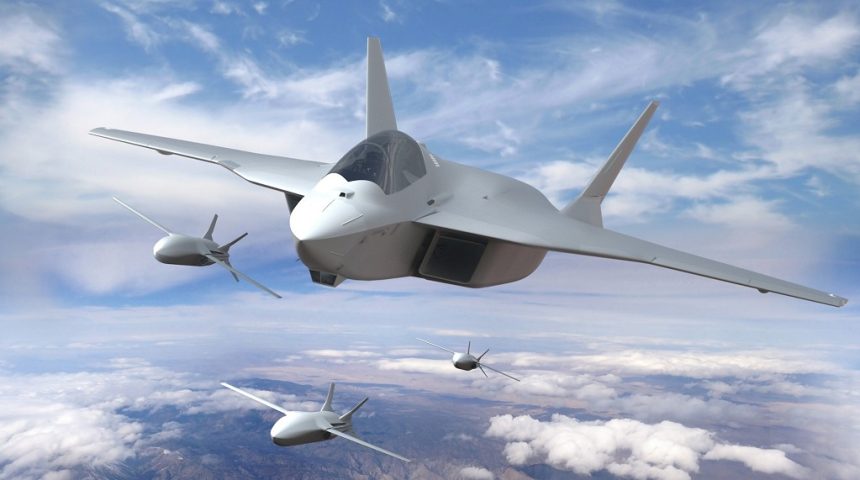Spain will be an equal nation along with France and Germany in the participation to the demonstrator phase of FCAS.
The Spanish industry has signed the initial framework contract for the Future Combat Air System’s (FCAS) Phase 1A Technology Demonstrators activities, completing the onboarding process, started in February, as an equal nation in the originally Franco-German programme. Airbus announced during its annual Trade Media Briefing that they will have the lead in the Spanish industrial effort for the New Generation Fighter (NGF) demonstrator and will also be the prime contractor for the Low Observability development.
According to Airbus, “the contract covers initial work on developing the programme demonstrators and maturing cutting-edge technologies, with the ambition to begin the NGF demo flight tests in the second half of 2026.”
In a tweet posted by the company, Bruno Fichefeux, Head of Future Combat Air System at Airbus, said: “With the official signature of the Spain industry contracts, all 3 partner nations and their industries are fully on-boarded on FCAS which will be the largest European defence collaborative programme for the 21st century.”
The third partner of the Joint Concept Study phase, Indra, joins Airbus and Dassault as Spain’s national coordinator. According to their press release, the companies working on the FCAS demonstrators are:
- In the Next Generation Fighter Demonstrator, led by Dassault Aviation, Airbus D&S SAU is the Main Partner alongside Airbus D&S GmbH;
- In the Engine Demonstrator, Safran Aircraft Engines is the Main Contractor, with ITP Aero and MTU Aero Engines as the Main Partners;
- In the Remote Carriers Demonstrator, led by Airbus D&S GmbH, SATNUS (a consortium comprising GMV, SENER Aeroespacial and TECNOBIT) is the Main Partner alongside MBDA;
- In the System of Systems/Combat Cloud Demonstrator, led by Airbus D&S GmbH, Indra is the Main Partner alongside Thales;
- In the JIPC/SIMLAB (Joint Inter-demonstrator Consistency/Simulation Laboratory) Demonstrator, Indra is a Co-Contractor alongside Dassault and Airbus D&S GmbH;
- In the Sensors Demonstrator, Indra is the Main Contractor, with Thales and the German FCMS as the Main Partners;
- In the ELOT (Low Observable Technologies) Demonstrator, Airbus D&S SAU is the Main Contractor, with Dassault and Airbus D&S GmbH as the Main Partners.

As we already reported, the Future Combat Air System (FCAS)/ Système de Combat Aérien Futur (SCAF) is the 6th generation stealth fighter aircraft designed to replace the Dassault Rafale and the Eurofighter Typhoon which was announced in 2018 and first unveiled during the Paris Air Show 2019. Airbus described it as a network-enabled system of systems that integrates a new generation fighter aircraft, unmanned MALE drones (medium-altitude, long endurance), the current aircraft fleet, cruise missiles and drone swarms. The Next Generation Weapon System (NGWS) will be the core of FCAS, comprising the NGF, the remote carriers and the Air Combat Cloud.
The timeline foresaw the initial demonstrator for this year, with the demonstrator development starting in 2021 and leading to flight tests in the 2026-2027 timeframe. Initial production in scheduled for 2035, with an introduction into service of the aircraft in 2040, five years later than the other European 6th generation aircraft, the Tempest (also named FCAS). Much like the United Kingdom, Germany is involving startups, small to medium enterprises (SMEs) and research institutes across the country to gather to best competencies to work on FCAS.
The Rafale and the Typhoon will also benefit from the FCAS development, receiving the new technologies to be fully integrated and interoperable with the FCAS’ Air Combat Cloud and Artificial Intelligence, as well as being able to operate with the remote carriers, the armed and surveillance drones controlled by the sixth-generation aircraft.
Dassault chief executive Eric Trappier said this summer that no more countries will be allowed to join the programme in the near future, as this would likely slow down the development, leading to delays in the ambitious schedule and possibly postponing the goal of the 2026 test flights. For the same reasons he also excluded a merge with the Tempest FCAS in the near future, while also leaving space for a cooperation later on. As a matter of fact, some of the companies involved (like MBDA) are already working on both programs.








